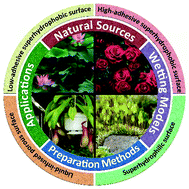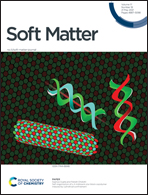Adhesion behaviors on four special wettable surfaces: natural sources, mechanisms, fabrications and applications
Abstract
The study of adhesion behaviors on solid–liquid surfaces plays an important role in scientific research and development in various fields, such as medicine, biology and agriculture. The contact angle and sliding angle of the liquid on the solid surface are commonly used to characterize and measure the wettability of a particular surface. They have a wide range of values, which results in different wettability. It boils down to the adhesion of solid surfaces to liquids. This feature article is aimed at revealing the essence of the adhesion behavior from the aspects of controlling the chemical composition or changing the geometrical microstructure of the surface, and reviewing the natural sources, wetting models, preparation methods and applications of four kinds of typical solid–liquid surfaces (low-adhesion superhydrophobic surfaces, high-adhesion superhydrophobic surfaces, slippery liquid-infused porous surfaces (SLIPS) and hydrophilic/superhydrophilic surfaces). Last, a summary and outlook on this field are given to point out the current challenges and the potential research directions of surface adhesion in the coming future.

- This article is part of the themed collection: Soft Matter Most Popular 2021


 Please wait while we load your content...
Please wait while we load your content...